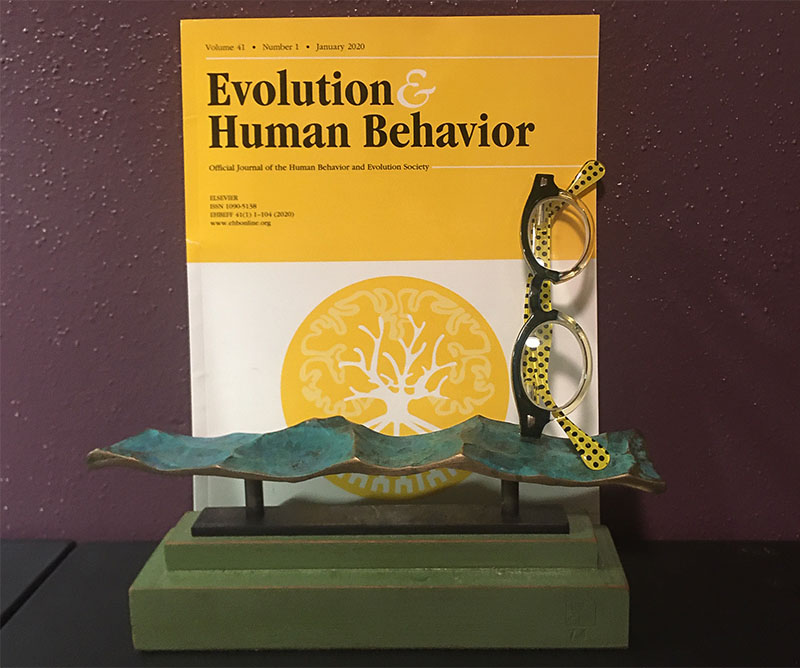Journal Articles and Contributions

EP Journal Websites
- Evolution and Human Behavior (Journal)
https://www.hbes.com/journals/
- EvoS Journal – The Journal of Evolutionary Studies
https://evostudies.org/evos-journal/about-the-journal/
- The Evolutionary Review — Art. Science. Culture.
http://www.evolutionaryreview.com/ed.htm
- Evolutionary Psychological Science (Journal)
https://www.springer.com/journal/40806
- Evolutionary Psychology (journal)
https://journals.sagepub.com/articles/EVP - Human Nature
https://www.springer.com/journal/12110
- Biology of Sex Differences – Journal of the Organization for the Study of Sex Differences
https://bsd.biomedcentral.com/
Articles and Contributions
Al-Sharwaf, L. (2019). Seven Key Misconceptions about Evolutionary Psychology. Areo. (August 20).
Baumeister, R.F., & Vohs, K. D. (2004). Sexual economics: sex as female resource for social exchange in heterosexual interactions. Personality and Social Psychology Review, 8, 339-363.
Bergner, D. (2009). What do women want. New York Times Magazine, January 25.
Buss, D. M. (2007). The evolution of human mating. Acta Psychologica Sinica, 39, (3), 502-512.
Buss, D. M., Shackelford, T., McKibbin, W. (2008). The mate retention inventory-short form (MRI-SF). Personality and Individual Differences, 44, 322-334.
Buss, D. M., & Shackelford, T. (2008). Attractive women want it all: good genes, economic investment, parenting proclivities, and emotional commitment. Evolutionary Psychology, 6(1): 134-146.
Buss, D.M., & Schmitt, D.P. (2011). Evolutionary psychology and feminism. Sex Roles, 64, 768-786.
Buss, D. M., & Schmitt, D. P. (1993). Sexual strategies theory: An evolutionary perspective on human mating. Psychological Review, 100, 204-232.
Buss, D.M., & von Hippel, W. (2018). Psychological barriers to evolutionary psychology: ideological bias and coalitional adaptations. Archives of Scientific Psychology, 6(1) 148-158.
Buss, D.M. (1989). Sex differences in human mate preferences: evolutionary hypotheses tested in 37 cultures. Behavior Brain Sciences, 12, 1-49.
Buss, D. M. (1988). The evolution of human intra-sexual competition: tactics of mate attraction. Journal of Personality and Social Psychology. 54, 616-628.
Buss, D.M. (1996a). Sexual conflict: evolutionary insights into feminism and the “battle of the sexes.” In Buss & Malamuth (Eds.). Sex, power, conflict: Evolutionary and feminist perspectives. (pp. 296-318). Oxford.
Cowley, G. (1996). The Biology of Beauty, Newsweek, June.
Eagly, A.H. (2016). When passionate advocates meet research on diversity, does the honest broker stand a chance? Journal of Social Issues, 72, 199-222.
Galperin, A., et al. (2012). Sexual regret: evidence for evolved sex differences. Arch of Sex Behav, Nov., online.
Gangestad, S., & Thornhill, R. (1994). Facial attractiveness, developmental stability, and fluctuating asymmetry. Ethnology and Sociobiology, 15(2) 73-85.
Gangestad, S., & Simpson, J.A. (2000). “The evolution of human mating: tradeoffs and strategic pluralism.” Behavioral and Brain Sciences, 23, 573-587.
Geher, G., & Gambacorta, D. (2010). Evolution is not relevant to sex difference in humans because I want it that way! Evidence for the politicization of human evolutionary psychology. EvoS Journal, Volume 2(1).
Gutierres, et al. (1999). Beauty, dominance, and the mating game: contrast effects reflect gender differences in mate selection. Personality and Social Psychology Bulletin, 25.
Johnson, V., Franklin, M. (1993). Is beauty in the eye of the beholder? Ethnology and Sociobiology, 14, 183-199.
Kanazawa, S. (2007). Ten politically incorrect truths about human nature. Psychology Today, July 1.
Langlois, J. et al. (1990). Infant differential social responses to attractive and unattractive faces. Developmental Psychology, 26, 153-159.
Langlois, J. (1990). Attractive faces are only average. Psychological Science, 1, 115-121.
Levine, M. (2001). Why I hate beauty. Psychology Today, July-August.
Li, N.P., (2008). Intelligent priorities: adaptive long- and short-term mate preferences. In Mating Intelligence, (Eds.) Geher & Miller.
Li, N.P. et al. (2002). The necessities and luxuries of mate preferences: testing the tradeoffs. Journal of Personality and Social Psychology, 82, No. 6, 947-955.
Li, N.P., & Kenrick, D. (2006). Sex similarities and differences in preference for short-term mates: what, whether and why. Journal of Personality and Social Psychology, Vol. 90, No. 3, 468-489.
Mackiel, A. (2019) What Explains the Resistance to Evolutionary Psychology? Quilette (April 8).
McAndrew, F. (2017). Beauty Cues, Psychology Today, November-December.
Nicholson, N. (1998) How hardwired is human behavior? Harvard Business Review. July-August
Paris, W., (2017). Laws of Attraction. Psychology Today, July-August.
Schmitt, D.P. (2017). The truth about sex differences. Psychology Today. (November).
Schmitt, D.P. & Shackelford, T. (2008). Big five traits related to short-term mating: from personality to promiscuity across 46 nations. Evolutionary Psychology, 6(2): 246-282.
Schmitt, D.P. et al. (2003). Universal sex differences in the desire for sexual variety: tests from 52 nations, 6 continents, and 13 islands. Journal of Personality and Social Psychology, 85, 85-104.
Schmitt, D., (2014). Evaluating evidence of mate preference adaptations: how do we really know what homo sapiens really want? Evolutionary Perspectives on Human Sexual Psychology and Behavior. Shackeford, Eds.
Udry, J.R. & Eckland, B.K. (1984). The benefits of being attractive: differential payoffs for men and women. Psychological Reports, 54, 47-56
Von Hippel, W. Buss, D.M. (2017). Do ideologically driven scientific agendas impede the understanding and acceptance of evolutionary principles in social psychology? In J.T Crawford & L. Jussim (Eds.), The Politics of Social Psychology, (pp. 7-26).
Waldman, A. (2013). The problem of female beauty. The New Yorker, October.